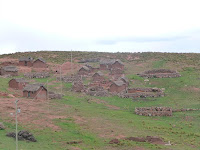The repeat section was a bit boring but I wasnt "dodging" rain clouds as I went this time. Its all at high altitude on the altiplano. And with the recent rain, that means that its mostly through green "open range" with lots of heards of llamas and alpacas and their atendants.
And there are literally hundreds of little villages scattered along the route. Some of them are right on the highway, but many of them are a Km or two or five off to one side or other.
Most of these little villages look to be very much "stone age". They are all made of mud brick and thatched roofs. There is little evidence of modernisation except for the odd corrugated iron roof here and there. Usually, there are no cars or other indications of "modern" transport either. So the scene is very much open green landscape with little clusters of brown mud buildings with thatched roofs and stacked stone fences... Very simple.
And another thing that I really notice is that in every one of these little villages there are a high percentage of unused buildings. And the unused buildings here are pretty easy to spot... The ones that are recently unused have their doors and windows blocked up with mud bricks but are otherwise intact. The buildings that have been unused for longer all have the roofs fallen in or missing completely. The walls are sometimes intact and protected by a thin "rim" of thatching, Or, often, just left to face the elements as they are... And that means that they are slowly disolving back into the earth.
And there are often whole villages that are abandoned and are reverting to nature "en mass" so to speak. I really like this "natural reabsorbtion" process here which is so unlike the villages in Mexico and other countries where all the buildings are made of cement blocks, concrete and steel reinforcing... They just stay around forever and look ugly!
I actually strongly suspect that the concret/cement buildings are nicer, cleaner, and more healthy (assorted insects and rodents cant live in steel and concrete as easily) to live in than the mud and thatch versions, but environmentaly and aesthetically, it seems to me that the mud version is nicer.
I wish there was some "middle ground" so to speak... You know, Nice to live in but "biodegradable" too :)










As a side note:
Any of these little villages that have over about ten to fifteen buildings, also has a church... And its usually the most "cliche" looking little "Spanish" church that you see in Western movies... You know, the adobe structure with the single two storie bell-tower attached to a hall with a peaked roof... Many of them are a bit decrepid with the adobe plaster falling away from the mud bricks in places. Quite beautiful really :)
Its also quite common for the church to be way out on its own in the middle of the open plain with no other buildings anywhere near. I assume this is because it has been placed at some central point for a "distributed" comunity.



So, if you ever want to make a photo essay on "old Spanish Churches" then the altiplano of Peru and Bolivia is where you want to go!!
Any of these little villages that have over about ten to fifteen buildings, also has a church... And its usually the most "cliche" looking little "Spanish" church that you see in Western movies... You know, the adobe structure with the single two storie bell-tower attached to a hall with a peaked roof... Many of them are a bit decrepid with the adobe plaster falling away from the mud bricks in places. Quite beautiful really :)
Its also quite common for the church to be way out on its own in the middle of the open plain with no other buildings anywhere near. I assume this is because it has been placed at some central point for a "distributed" comunity.



So, if you ever want to make a photo essay on "old Spanish Churches" then the altiplano of Peru and Bolivia is where you want to go!!

